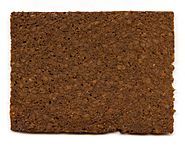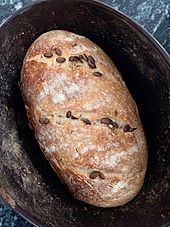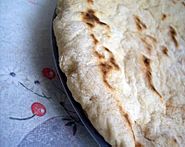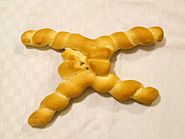List of sourdough breads facts for kids
This is a list of sourdough breads. Sourdough is prepared through the fermentation of dough using naturally occurring lactobacilli and yeast. The lactic acid produced by the lactobacilli imbues it a more sour taste, as well as extending its shelf life compared to other breads. Sourdough baking has a devoted community today. Many devotees share starters and tips via the Internet, and hobbyists often proudly share their work on social media.
Sourdough breads
- Amish friendship bread is a type of bread or cake made from a sourdough starter that is often shared in a manner similar to a chain letter. The starter is a replacement for baking yeast. It can be used to make many kinds of yeast-based breads, shared with friends, or frozen for future use. The sweet, cake-like Amish cinnamon bread is a common bread that is made from this starter. It is a simple, stirred quickbread. It includes a large amount of sugar and vegetable oil, with a mild cinnamon flavor. It has characteristics of both pound cake and coffee cake. The flavor of the finished product can be changed by not using cinnamon. no
- Bazlama is a leavened, circular flatbread from Turkish cuisine. It has an average thickness of 2 cm and diameters ranging from 10 to 25 cm. no
- Borodinsky bread (Russian: бородинский хлеб borodinskiy khleb) or borodino bread is a dark brown sourdough rye bread of Russian origin, traditionally sweetened with molasses and flavored with coriander and caraway seeds. no
- The German word Butterbrot (literally: butter bread = bread with butter) describes a slice of bread topped with butter. The slice of bread could be served with cheese, sweet toppings or a slice of sausage and it is still called Butterbrot. The words in formal and colloquial German and the different dialects for butterbrot (different from belegtes Brot - with cheese, sausages etc.), simply Brot ("bread"), Butterstulle, Stulle, Schnitte (all three Low German/Berlinerisch dialect), Botteramm (Colognian dialect, cf. Dutch boterham), Bütterken (Lower Rhine dialect) to Bemme (Upper Saxon German) or Knifte (Ruhrdeutsch). Although it is increasingly replaced by other foods, it remains a common staple food in Germany. Since 1999, the last Friday in the month of September was made the Day of German Butterbrot by the Marketing Organization of German Agricultural Industries. Russian adopted the term buterbrod (бутерброд) from New High German (Butterbrot), perhaps as early as the 17th century during the reign of Peter the Great. In modern Russian the term has a more general meaning, whatever the ingredient on top of the slice of bread is. From Russian, the term buterbrod was adopted into Azerbaijani, Belarusian, Georgian, Kazakh, Ukrainian, and Lithuanian. no
- Coppia ferrarese [ˈkɔppja ferraˈreːze], also known as ciopa, ciupeta and pane ferrarese, is a type of sourdough bread made with flour, lard, malt, and olive oil, and has a twisted shape. It was first made around the thirteenth century in Ferrara, Italy. It has PGI status under European Law, which was obtained in 2001. no
- Eish merahrah (Egyptian Arabic: عيش مرحرح, [ʕeːʃ meˈɾɑħɾɑħ], "smoothed-out bread", "spread-out bread") is a flatbread, made with ground fenugreek seeds and maize, eaten in Egypt. It is part of the traditional diet of the Egyptian countryside, prepared locally in village homes in Upper Egypt. The loaves are flat and wide, and usually about 50 cm in diameter. A soft dough is made with the maize flour and left to ferment overnight with a sourdough starter, shaped into round loaves, and then allowed to rise or “proof” for 30 minutes before being flattened into round disks and baked. no
- Eish shamsi (Egyptian Arabic: عيش شمسي), is a thick sourdough bread eaten in Egypt made with wheat flour. In Upper Egypt it replaces eish baladi as the local staple, although the latter is common as well. The name, which translates to "sun bread", is thought to derive from the practice of letting the dough rise in the sun. The bread is traditionally baked at home in domed clay ovens with openings at the top, although this tradition is fading with pre-made bread becoming increasingly common. no
- Herman cake (often called Herman) is a 'friendship cake'. Similar to the Amish friendship bread, the starter is passed from person to person (like a chain letter) and continues to grow as it contains yeast and lactic acid bacteria. One starter can, in theory, last indefinitely. The other ingredients for the mixture are milk, sugar, flour and warm water. They became popular in the 1970s. no

Ethiopian injera with its typical spongy texture
- Injera (Amharic: እንጀራ, romanized: ənǧära, [ɨndʒəra]; Oromo: Biddeena; Tigrinya: ጣይታ, romanized: ṭayta) is a sour fermented pancake-like flatbread with a slightly spongy texture, traditionally made of teff flour. In Ethiopia, Eritrea, and some parts of Sudan, injera is the staple. Injera is central to the dining process, like bread or rice elsewhere. no
- Kommissbrot, formerly Kommißbrot, is a dark type of German bread, baked from rye and other flours, historically used for military provisions. no
- Maltese bread (Maltese: Il-Ħobż tal-Malti, tal-malti) is a crusty sourdough bread from Malta, usually baked in wood ovens. It is typically eaten with spread olive oil (Ħobż biż-żejt), where the bread is rubbed with tomatoes (as with the Catalan pa amb tomàquet) or tomato paste, drizzled with olive oil and filled with a choice or mix of tuna, olives, capers, onion, bigilla and ġbejna. The practice of making the bread is considered a 'dying art.' no

A slice of pumpernickel
- Pumpernickel is a typically heavy, slightly sweet rye bread traditionally made with sourdough starter and coarsely ground rye. It is often made today with a combination of flour made from rye as well as whole rye grains ("rye berries"). no
- Rugbrød (Danish pronunciation: [ˈʁu:ˌpʁœðˀ]) is a very common form of rye bread from Denmark. Rugbrød usually resembles a long brown extruded rectangle, no more than 12 cm high, and 30–35 cm wide, depending on the bread pan in which it is baked. The basic ingredient is rye flour which will produce a plain or "old-fashioned" bread of uniform, somewhat heavy structure, but the most popular versions today contain whole grains (cracked or chopped rye kernels) and often other seeds such as sunflower seeds, linseeds or pumpkin seeds.
Gallery
See also
- Carl Griffith's sourdough starter
- Desem
- Herculaneum loaf
- List of microorganisms found in sourdough
- List of breads
- The Puratos Sourdough Library – the only facility in the world dedicated to housing sourdough cultures

All content from Kiddle encyclopedia articles (including the article images and facts) can be freely used under Attribution-ShareAlike license, unless stated otherwise. Cite this article:
List of sourdough breads Facts for Kids. Kiddle Encyclopedia.









